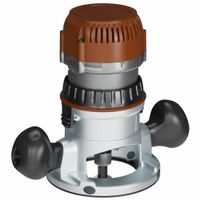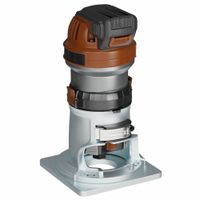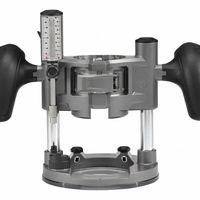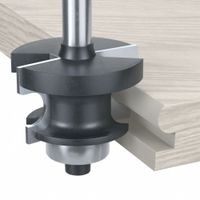Call +(254) 703 030 000 / 751 483 999 / 721 704 777
- Home
- Tools
- Power Tools
- Routers Bits Wood Shapers
.....Read More
Frequently Asked Questions
What is the difference between a router and a wood shaper?
A router and a wood shaper are both woodworking tools used for shaping and finishing wood, but they differ in design, functionality, and application.
A router is a handheld or table-mounted tool that uses a high-speed rotating bit to hollow out or shape wood. It is versatile and can perform a variety of tasks such as cutting grooves, creating decorative edges, and making joints. Routers are generally smaller, more portable, and suitable for detailed work. They come in two main types: fixed-base and plunge, allowing for different depths of cut. Routers are ideal for intricate designs and are often used in cabinetry and furniture making.
A wood shaper, on the other hand, is a larger, stationary machine designed for more heavy-duty work. It uses a spindle to hold larger cutter heads, which can be adjusted for different profiles and depths. Shapers are typically used for producing moldings, raised panels, and other large-scale projects. They offer more power and stability, making them suitable for handling larger pieces of wood. Shapers can accommodate larger bits and cutters, providing more options for complex profiles and deeper cuts.
In summary, the main differences lie in their size, power, and application. Routers are more versatile and portable, suitable for detailed and smaller projects, while wood shapers are larger, more powerful, and better suited for heavy-duty, large-scale work.
How do I choose the right router bit for my project?
To choose the right router bit for your project, consider the following factors:
1. **Material**: Determine the material you will be working with, such as wood, plastic, or metal. Different materials require different types of bits. For example, carbide-tipped bits are ideal for hardwoods and laminates, while high-speed steel bits are suitable for softer woods.
2. **Bit Type**: Identify the type of cut you need. Common bit types include straight bits for cutting straight lines, flush-trim bits for trimming edges, and round-over bits for creating rounded edges. Choose a bit that matches the specific cut or profile you want to achieve.
3. **Shank Size**: Check the shank size of the bit, which is the part that fits into the router. Common sizes are 1/4 inch and 1/2 inch. Ensure your router is compatible with the shank size. A 1/2-inch shank offers more stability and less vibration, making it preferable for larger projects.
4. **Cutting Diameter and Length**: Consider the diameter and length of the cutting edge. Larger diameters remove more material and are suitable for bigger projects, while smaller diameters are better for detailed work. The cutting length should match the depth of the cut you need.
5. **Quality and Brand**: Invest in high-quality bits from reputable brands. They last longer, provide cleaner cuts, and are more reliable. Cheap bits may wear out quickly and produce inferior results.
6. **Project Requirements**: Assess the specific requirements of your project, such as the need for decorative edges or joinery. This will guide you in selecting specialized bits like dovetail or chamfer bits.
7. **Router Compatibility**: Ensure the bit is compatible with your router's speed and power. Some bits require variable speed routers to prevent burning or chipping.
By considering these factors, you can select the right router bit that meets your project's needs and ensures optimal performance.
What are the advantages of using a CNC router table?
A CNC router table offers numerous advantages, enhancing efficiency, precision, and versatility in various applications:
1. **Precision and Accuracy**: CNC router tables provide high levels of precision and accuracy, ensuring consistent and repeatable results. This is crucial for intricate designs and detailed work, reducing human error and material waste.
2. **Automation and Efficiency**: These machines automate the cutting process, significantly increasing production speed. They can operate continuously with minimal supervision, optimizing workflow and reducing labor costs.
3. **Versatility**: CNC router tables can work with a wide range of materials, including wood, plastics, metals, and composites. This versatility makes them suitable for diverse industries such as woodworking, signage, and aerospace.
4. **Complex Designs**: They can execute complex and intricate designs that would be challenging or impossible to achieve manually. This capability expands creative possibilities and allows for the production of sophisticated products.
5. **Reduced Waste**: The precision of CNC router tables minimizes material waste, leading to cost savings and more sustainable operations. The ability to optimize material usage is beneficial for both the environment and the bottom line.
6. **Ease of Use**: With user-friendly software interfaces, CNC router tables are accessible to operators with varying skill levels. This ease of use reduces the learning curve and allows for quick adaptation to new projects.
7. **Consistency**: Once a design is programmed, the CNC router can produce identical copies with consistent quality, essential for mass production and maintaining brand standards.
8. **Safety**: By automating the cutting process, CNC router tables reduce the need for manual intervention, enhancing workplace safety and reducing the risk of accidents.
9. **Cost-Effectiveness**: Over time, the efficiency and reduced labor costs associated with CNC router tables can lead to significant financial savings, making them a cost-effective investment for businesses.
How do I maintain and clean my router bits?
To maintain and clean your router bits, follow these steps:
1. **Regular Inspection**: Frequently check your router bits for signs of wear, such as dullness, chips, or rust. Replace any damaged bits to ensure safety and precision.
2. **Cleaning**: After each use, clean the bits to remove resin, pitch, and wood debris. Use a soft brush or cloth to wipe off loose particles. For stubborn residues, soak the bits in a cleaning solution like a commercial bit cleaner or a mixture of water and household detergent. Avoid harsh chemicals that might damage the carbide.
3. **Drying**: Thoroughly dry the bits after cleaning to prevent rust. Use a soft cloth or air dry them completely.
4. **Sharpening**: Keep the bits sharp for optimal performance. Use a diamond hone or a professional sharpening service. Be cautious not to alter the bit's profile while sharpening.
5. **Lubrication**: Apply a light coat of machine oil or a rust inhibitor to the bits after cleaning and drying to protect against corrosion.
6. **Proper Storage**: Store router bits in a dry, organized manner. Use a dedicated bit holder or case to prevent them from knocking against each other, which can cause damage.
7. **Usage Practices**: Use the bits at the recommended speed and feed rate to avoid overheating and dulling. Ensure the router is properly aligned to reduce stress on the bits.
8. **Safety Gear**: Always wear safety gear, such as goggles and gloves, when handling and cleaning router bits to protect against injury.
By following these steps, you can extend the life of your router bits and maintain their performance.
What safety precautions should I take when using a router?
When using a router, prioritize safety by following these precautions:
1. **Wear Protective Gear**: Always wear safety goggles to protect your eyes from flying debris and ear protection to guard against noise. Use a dust mask to avoid inhaling wood particles.
2. **Secure Workpiece**: Ensure the workpiece is firmly clamped or secured to prevent movement during operation, reducing the risk of kickback.
3. **Inspect the Router**: Before use, check the router for any damage or loose parts. Ensure the bit is sharp and properly installed, and the collet is tightened securely.
4. **Use the Right Bit**: Select the appropriate bit for the material and task. Avoid using damaged or dull bits, as they can cause the router to bind or kick back.
5. **Check the Power Source**: Ensure the router is unplugged when changing bits or making adjustments. Use a grounded outlet and avoid using the router in wet conditions to prevent electrical hazards.
6. **Set the Correct Speed**: Adjust the router speed according to the bit size and material. Larger bits require slower speeds to maintain control and prevent overheating.
7. **Maintain a Firm Grip**: Hold the router with both hands and maintain a stable stance. Keep your hands away from the bit and cutting area.
8. **Follow the Feed Direction**: Move the router against the rotation of the bit to maintain control and achieve a clean cut.
9. **Avoid Distractions**: Stay focused and avoid using the router when tired or under the influence of substances that impair judgment.
10. **Keep the Work Area Clean**: Remove any clutter or obstacles from the work area to prevent tripping or accidental contact with the router.
11. **Turn Off and Unplug**: After use, turn off the router and unplug it before cleaning or making any adjustments. Store it safely to prevent unauthorized use.
How do I set up a router for table mounting?
1. **Choose the Right Router and Table**: Ensure your router is compatible with the table. Check the base plate size and mounting hole pattern.
2. **Gather Tools and Materials**: You'll need a screwdriver, wrench, drill, and mounting hardware. Some setups may require a router lift for easy adjustments.
3. **Prepare the Router Table**: Clear the table surface. If the table has a pre-drilled plate, ensure it matches your router. If not, you may need to drill new holes.
4. **Attach the Router Base Plate**: Remove the router’s base plate. Align the router’s mounting holes with the table’s insert plate. Secure it using screws or bolts provided.
5. **Install the Router**: Position the router under the table. Align it with the mounting plate. Secure it using the appropriate screws or bolts. Ensure it’s tightly fastened to prevent movement.
6. **Adjust the Router Bit Height**: Use a router lift or adjust manually. Ensure the bit is at the desired height for your project. Lock it in place to maintain consistency.
7. **Check for Stability**: Ensure the router is securely mounted. Test for any movement or wobbling. Tighten any loose screws or bolts.
8. **Connect Power and Test**: Plug in the router. Test it at a low speed to ensure it operates smoothly. Check for any unusual vibrations or noises.
9. **Install Safety Features**: Attach a safety guard and dust collection system if available. Ensure the power switch is easily accessible.
10. **Final Adjustments**: Make any necessary adjustments to the fence and miter gauge. Ensure everything is aligned and secure before starting your project.
What are the benefits of using a cordless router over a corded one?
A cordless router offers several benefits over a corded one, primarily centered around convenience, flexibility, and safety.
1. **Portability**: Cordless routers are highly portable, allowing users to move freely without being tethered to a power outlet. This is particularly advantageous for tasks in remote locations or large workspaces where power sources are not readily available.
2. **Ease of Use**: Without a cord, users can maneuver the router more easily, which is beneficial for intricate or detailed work. The absence of a cord also eliminates the risk of tangling or tripping, enhancing user safety and reducing the likelihood of accidents.
3. **Versatility**: Cordless routers can be used in a variety of settings, both indoors and outdoors, without the need for extension cords. This versatility makes them suitable for a wide range of projects, from home improvement to professional carpentry.
4. **Time Efficiency**: The setup time is reduced as there is no need to find a power source or manage cords. This can lead to increased productivity, especially in environments where time is a critical factor.
5. **Safety**: The lack of a cord reduces the risk of electrical hazards, such as short circuits or electric shocks. It also minimizes the chance of accidentally cutting the cord during operation, which can be a significant safety concern with corded routers.
6. **Modern Features**: Many cordless routers come equipped with advanced features like brushless motors, variable speed controls, and ergonomic designs, which enhance performance and user comfort.
7. **Battery Technology**: Advances in battery technology have improved the runtime and power of cordless routers, making them competitive with their corded counterparts in terms of performance.
Overall, the benefits of using a cordless router include enhanced mobility, ease of use, and safety, making them a preferred choice for many woodworking and DIY enthusiasts.






